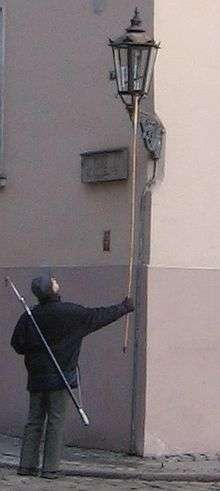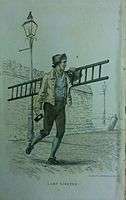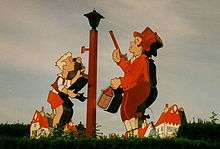Lamplighter


A lamplighter is a person employed to light and maintain street lights. Very few exist today as most street lighting has long been by electric lamps.
Function
Lights were lit each evening, generally by means of a wick on a long pole. At dawn, they would return to put them out using a small hook on the same pole. Early street lights were generally candles, oil, and similar consumable liquid or solid lighting sources with wicks.
Other duties
Another lamplighter duty was to carry a ladder and renew the candles, oil, or gas mantles.
In some communities, lamplighters served in a role akin to a town watchman; in others, it may have been seen as little more than a sinecure.
In the 19th century, gas lights became the dominant form of street lighting. Early gaslights required lamplighters, but eventually systems were developed which allowed the lights to operate automatically.
Today
Today a lamplighter is an extremely rare job. In Brest as a tourist attraction a lamplighter has been employed since 2009 to light up the kerosene lamps in the shopping street every day.[1]
A small team of lamplighters still operate in London, England where gas lights have been installed by English Heritage.[2]
In Waikiki, Hawaii, lamplighters in traditional Hawaiian costumes run along the shore and light gas torches in the evening.
There is a long history of the role of a lamplighter-as-lightbringer as a symbolic figure in literature.
Frank Serpico, an NYPD whistleblower, prefers to use the term "lamp-lighter" to describe the whistleblower's role as a watchman.[3]
Tinker Tailor Soldier Spy, a spy novel written by John le Carré in it refers to Lamplighters as a section of British Intelligence that provided surveillance and couriers [4]
Lamplighter's Serenade is a song written by Hoagy Carmichael. it was recorded by Frank Sinatra during his first session as a solo artist, on January 19, 1942. Bing Crosby also recorded a version of the song just days later.
Modern outdoors usage

In the 20th century, most cities with gas streetlights replaced them with new electric streetlights. For example, Baltimore, the first US city to install gas streetlights, removed nearly all of them in 1957. A gas lamp is located at N. Holliday Street and E. Baltimore Street as a monument to the first gas lamp in America, erected at that location.[5]
However, gas lighting of streets has not disappeared completely from some cities, and the few municipalities that retained gas lighting now find that it provides a pleasing nostalgic effect. Gas lighting is also seeing a resurgence in the luxury home market for those in search of historical authenticity.
The largest gas lighting network in the world is that of Berlin. With about 37,000 lamps (2014),[6] it holds more than half of all working gas street lamps in the world. In central London around 1500 gas lamps still operate,[7] lighting the Royal Parks, the exterior of Buckingham Palace and almost the entire Covent Garden area. The Park Estate in Nottingham retains much of its original character, including the original gas lighting network.
In the United States, more than 2800 gas lights in Boston operate in the historic districts of Beacon Hill, Back Bay, Bay Village, Charlestown, and parts of other neighborhoods. In Cincinnati, Ohio, more than 1100 gas lights operate in areas that have been named historic districts. Gas lights also operate in parts of the famed French Quarter and outside historic homes throughout the city in New Orleans.
South Orange, New Jersey, has adopted the gaslight as the symbol of the town, and uses them on nearly all streets. Several other towns in New Jersey also retain gas lighting: Glen Ridge, Palmyra, Riverton, and some parts of Orange, Cape May and Cherry Hill. The village of Riverside, Illinois, still uses its original gas street lights that are an original feature of the Frederick Law Olmsted planned community. Manhattan Beach, California, has a gas lamp section in which all the sidewalks are lit by public gas lamps. Disneyland has authentic 19th century gas lamps from Baltimore along the "Main Street, U.S.A." section of the theme park.
Many gas utility companies will still quote a fixed periodic rate for a customer-maintained gas lamp, and some homeowners still use such devices. However, the high cost of natural gas lighting[8] at least partly explains why a large number of older gas lamps have been converted to electricity. Solar-rechargeable battery-powered gas light controllers can be easily retrofitted into existing gas lamps to keep the lights off during daylight hours and cut energy consumption and green-house gas carbon emissions by 50%.
- Lamplighters in art
 Lithograph published in The World in Miniature(London, Rudolph Ackermann, 1821–25)
Lithograph published in The World in Miniature(London, Rudolph Ackermann, 1821–25) Lamplighter pubsign Stratford-upon-Avon, in England
Lamplighter pubsign Stratford-upon-Avon, in England Historic Howard Johnson's motel "lamplighter" sign in front of a property in Albany, New York
Historic Howard Johnson's motel "lamplighter" sign in front of a property in Albany, New York- De Lantaarnopsteker by H.S. Bosma in Veenhuizen (2006)
Notes
- ↑ Юрий Рубашевский. (2009-07-29). Тепло и свет "живого" фонаря (in Russian). Vecherniy Brest.
- ↑ "Enchanting story of our last gas street lights, and the five men who keep them burning - Daily Mail Online". Mail Online. 24 November 2014.
- ↑ Frank Serpico section, The Independent, U.K.
- ↑ "The secret codes of John le Carré's Tinker Tailor Soldier Spy". Telegraph.co.uk. 15 September 2011.
- ↑ Rasmussen, Frederick (1998-10-10). "City's gaslight glow dimmed in 1957 Progress: The American gas industry was born in Baltimore in 1816, when an artist wanted a clean, smoke-free way to illuminate a roomful of paintings". Baltimore Sun. Retrieved 2013-06-22.
- ↑ "Berlins Gaslight Culture association". Retrieved 6 March 2016.
- ↑ Freeman, Laura (24 November 2014). "The most magical job in Britain: Enchanting story of our last gas street lights, and the five men who keep them burning just as they did in Dickens' day". Daily Mail. Retrieved 21 March 2015.
- ↑ Aren Cambre’s Blog » Blog Archive » Gas Lamps are Expensive
External links
 Media related to Lamplighter at Wikimedia Commons
Media related to Lamplighter at Wikimedia Commons